

7 Must-Have Neuroscience Apps and Tools for Educators. Know Students Better: 15 Tools for Formative Assessment. When teachers know their students well, they can build strong connections that lead to better learning.
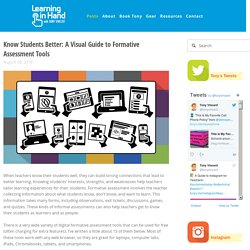
Knowing students’ interests, strengths, and weaknesses help teachers tailor learning experiences for their students. Bill would lift school penalties for opt-out students. Updated 11:36 am, Saturday, January 9, 2016.

Creative Ways to Grade and Provide Feedback for Students. Teachers work very hard to give all students as much feedback on their work as possible.
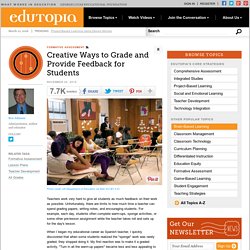
Unfortunately, there are limits to how much time a teacher can spend grading papers, writing notes, and encouraging students. For example, each day, students often complete warm-ups, sponge activities, or some other pre-lesson assignment while the teacher takes roll and sets up for the day's lesson. Educational Leadership:Using Assessments Thoughtfully:The Bridge Between Today's Lesson and Tomorrow's. Going Gradeless: Student Self-Assessment in PBL. I like reading professional material.
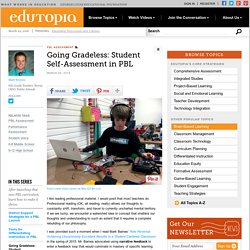
Watch: North Texas teacher's video parody of Macklemore's 'Thrift Shop' gets an A+ Photo: YouTube/Lady Hauza, Courtesy.

New test requires North Dakota students to prove civics proficiency. Last year, North Dakota became the second state in the nation to adopt the requirement, which is based on the Immigration and Naturalization test covering questions about government and history.
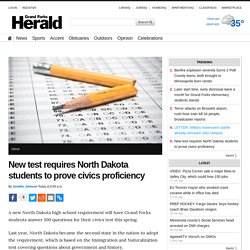
Education researchers blast Common Core standards, urge ban on high-stakes tests. Stacey Jacobson-Francis works on math homework with her 6-year-old daughter Luci on May 14, 2014, at their home in Berkeley, Calif.

(AP) More than 100 education researchers in California have joined in a call for an end to high-stakes testing, saying that there is no “compelling” evidence to support the idea that the Common Core State Standards will improve the quality of education for children or close the achievement gap, and that Common Core assessments lack “validity, reliability and fairness.” The California Alliance of Researchers for Equity in Education, a statewide collaborative of university-based education researchers, recently released a research brief (see in full below below) describing concerns with the Common Core standards and the assessments being given to millions of students in California and other states around the country this spring.
[What the Common Core tests are — and aren’t]
The power of stealth assessment. SmartBlog on Education this month is exploring assessments and testing.
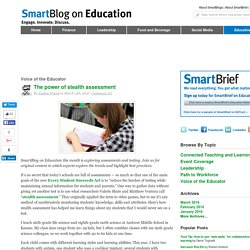
Join us for original content in which experts explore the trends and highlight best practices. It’s no secret that today’s schools are full of assessments — so much so that one of the main goals of the new Every Student Succeeds Act is to “reduce the burden of testing while maintaining annual information for students and parents.” One way to gather data without giving yet another test is to use what researchers Valerie Shute and Matthew Ventura call “stealth assessment.” They originally applied the term to video games, but to me it’s any method of unobtrusively monitoring students’ knowledge, skills and attributes. Online state tests got worse scores than paper. Judging from a key measure on the state report card, Ohio school districts that gave last spring's proficiency tests solely with paper and pencil appear to have performed much better than those districts that did all testing online.
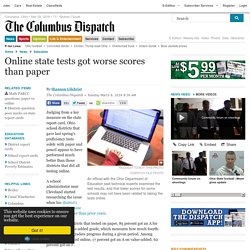
A school administrator near Cleveland started researching the issue when his district's 2014-15 grades were dramatically lower than prior years. Among Ohio districts that tested on paper, 85 percent got an A for their overall value-added grade, which measures how much fourth- through eighth-graders progress during a given period. Among districts that tested online, 17 percent got an A on value-added; 62 percent got an F. >> See a comparison of questions on the paper test and the online test (PDF) One Franklin County district that saw a precipitous drop in its value-added scores was Worthington schools, which got four Fs. “I’m not against online testing.
Officials from the Ohio Department of Education dispute that the chosen format is a factor. @shangilchrist. Avoiding assessment agita @fredende SmartBlogs. SmartBlog on Education this month is exploring assessments and testing.
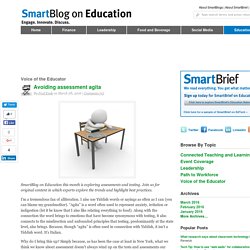
Academic expectations around the country, updated for Common Core. Last summer I pointed out how wildly different academic expectations were around the country, just before the introduction of the Common Core standards. Some states set the passing marks on their annual standardized tests more than four grade levels behind those of other states. Far higher share of students are passing at least one AP test during high school.
Advanced Placement World History teacher Mike Shannon, right, at Poolesville High School, on April 4, 2014 in Poolesville, Md. Maryland led the nation in terms of the percentage of its students in the Class of 2015 who passed at least one Advanced Placement test during high school. (Bill O’Leary/The Washington Post) This post has been updated to include the state-by-state rankings, below. More than 22 percent of the nation’s public school students from the Class of 2015 passed at least one Advanced Placement test during high school, according to data released Wednesday, a big jump from the roughly 13 percent who accomplished the feat a decade earlier.
Many who pass state high school graduation tests show up to college unprepared. Looking back on her junior year at Saint Agnes Academic High School in the College Point neighborhood of Queens, Viktoria Mertiri admits that trigonometry “was the death of me. I never understood it.” But Mertiri scored a 70 on the New York Regents Examination, a state standardized test of core high school subjects. It was a pleasant surprise: five points better than she needed to pass.
In geometry, she scored an 85. She also passed the English language arts, U.S. history, global history, and a science Regents — with math, the five exams a student must pass, by law, to graduate from high school in New York State and receive a Regents diploma. When she arrived at Queensborough Community College, however, Mertiri, who is now 20, did poorly on the entrance tests and was put in remedial classes. Related: Low-income students struggle to pay for college, even in rare states that offer help. Should Ohio schools be held harmless if students opt out of state tests? Is more physical education at school linked to higher student math scores? Students swing on the playground at KIPP DC Grow Academy in the Truxton Circle neighborhood. (Amanda Voisard for The Washington Post) The amount of time students spend doing physical activity in school appears to be linked to higher standardized math scores in D.C. schools, according to a new American University study that examined the success of the city’s Healthy Schools Act and found that schools offering more physical activity had significantly better math success.
The law, passed in 2010, requires D.C. public and public charter schools to adhere to requirements for what food must be served and how much physical activity should be built into each school week. The schools received funding as part of the legislation and were required to report how they implemented the program. Since the Healthy Schools Act was passed, the District’s schools have been required to incrementally increase the amount of physical education offered to elementary and middle school students each year. Assessment Tool: Quizizz.
5 Ways ESSA Impacts Standardized Testing. The No Child Left Behind era has come to an end. On December 10, President Obama signed the Every Student Succeeds Act (ESSA), which replaces NCLB as the latest iteration of the Elementary and Secondary Education Act (ESEA, the nation's main K-12 education law). The education community (at least at the national level) largely supports the new law. Policy wonks are touting the reversal of a long-standing trend towards federal involvement in education and the return of control from states to districts over key education initiatives like accountability, school turnarounds, and teacher evaluations. New research suggests that SAT under- or overpredicts first-year grades for hundreds of thousands. Deeper learning. Three Ways to Incorporate Formative Assessment into Every Classroom. By Jasper Fox Sr. 5 Formative Assessment Tools.
Standardized Testing is not Teaching. Standardized Testing – Student Voice Goes Viral. Psychologist: The Common Core Tests Cannot Be Independently Verified for Validity or Reliability. Vermont suspends use of standardized test scores. During PARCC testing, schools losing art, music, other 'specials' Random Sunday Thoughts - Standardized Tests. As Students Opt Out of Common Core Exams, Some Say Movement Is Not About Testing.